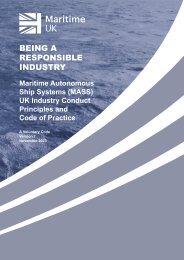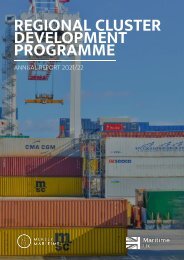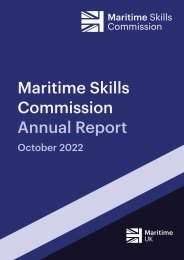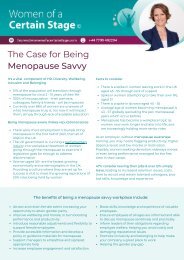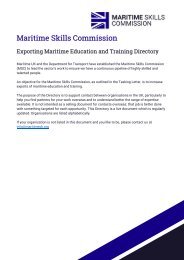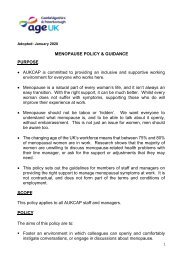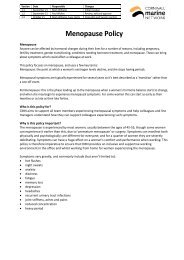code_of_practice_V3_2019
Create successful ePaper yourself
Turn your PDF publications into a flip-book with our unique Google optimized e-Paper software.
Control is typically a combination <strong>of</strong> high level and low level functions and behaviours, which may be implemented in<br />
separate modules, such as the following examples:<br />
n Sub-second control <strong>of</strong> a rudder actuator, with a feedback loop in order to control heading in response to<br />
Heading and Rate <strong>of</strong> Turn (ROT) set points;<br />
n Following a sequence <strong>of</strong> waypoints by issuing Heading and ROT set points;<br />
n Generating or selecting waypoints, and selecting which route to follow;<br />
n Enabling waypoint-following, or superseding the mission controller with heading and speed set points<br />
calculated by a collision avoidance algorithm.<br />
8.9.2 It should be noted that the MASS’s ability to transmit situational awareness data to an <strong>of</strong>f-board controller has<br />
been covered in the previous Chapter. This, and the ability to receive appropriate and timely commands from the<br />
controller, should be borne in mind in cases where some <strong>of</strong> these functions are performed remotely.<br />
8.9.3 The control functions, (on-board, remote, or distributed) shall be capable <strong>of</strong> exerting timely and accurate control<br />
in such a manner as to maintain safety <strong>of</strong> (1) the platform; (2) surrounding persons, structures, ships; and (3) the<br />
environment.<br />
8.10 EMERGENCY STOP<br />
8.10.1 The MASS should have a defined condition <strong>of</strong> Emergency Stop, which must be fail safe under conditions where<br />
normal control <strong>of</strong> the MASS is lost. Under Emergency Stop, propulsion is reduced to a safe level in a timely<br />
manner. In this context:<br />
n “a safe level” means a level at which it is not likely to cause damage either directly or indirectly. It should be<br />
noted that some MASS (e.g. wave propelled) may not have any means <strong>of</strong> cutting propulsion power to zero.<br />
But in a harbour or sheltered waters the wave propulsive power may reasonably be expected to be a safely<br />
low level;<br />
n “in a timely manner” means within a time that is short enough to ensure that the risk from uncontrolled<br />
propulsive power can be contained before it is likely to cause damage. In open ocean conditions this may be<br />
relaxed, whereas in a docking situation the propulsion may need to be cut more quickly, within seconds or less.<br />
8.10.2 The MASS shall have the ability to be placed in an Emergency Stop condition by a human or automatic controller<br />
or supervisor with access to sufficient Situational Awareness data to be able to determine when an Emergency<br />
Stop command is necessary.<br />
8.10.3 In the case <strong>of</strong> an automatic operator, the design <strong>of</strong> that controller or supervisor shall be fail safe, in that it<br />
shall recognise all known unsafe operating conditions with no false negatives and shall react to unknown or<br />
indeterminate safety conditions by invoking Emergency Stop in a timely manner.<br />
8.10.4 On sensing a failure (or disabling, whether deliberate or not) <strong>of</strong> all data-links which may carry an emergency stop<br />
command, the MASS shall enter a ‘render-safe’ procedure. This should culminate in Emergency Stop. The first action<br />
should be that, if situational awareness has been, and continues to be, fully operational, the MASS should<br />
immediately shape a safe course and adopt a ‘safe speed’ (making appropriate sound and visual signals when<br />
feasible) commensurate with weather conditions, COLREGS and safe navigation at the time <strong>of</strong> loss <strong>of</strong> data-link.<br />
This should minimise hazards to the MASS and other vessels, whilst the MASS and the control station resolve the<br />
situation. If the data-link is not re-established after an appropriate grace time, and/or the MASS’s own situational<br />
awareness deems it safe/necessary, the MASS should enter Emergency Stop. Consideration may be made <strong>of</strong> including<br />
‘dropping anchor’ as part <strong>of</strong> the render-safe procedure, commensurate with accepted safe navigation <strong>practice</strong>s.<br />
56<br />
MASS UK Industry Conduct Principles and Code <strong>of</strong> Practice Version 3




